Menus
- New re-evolution
- Discovery
- In the saddle
- In the city
- Motorway and expressways
- Departmental
- Part-cycle
- Braking
- Comfort / Duo
- Consumption
- Conclusion
- Colors
New re-evolution
High-end road symbol of the manufacturer with tuning forks, the FJR 1300 descends from a long line of dynamic travelers. The first of all is called FJ 1100, sporty from 1984, declined until 1995 on a more GT line and cubing at its disappearance 1200 cm3. It will then take 6 years to deliver its replacement.
Its descendant then continues to evolve since its first turns of the wheels in 2001. Five years later, two versions appear: FJR 1300 A and AS. The latter, hyper-technological, incorporates for the first time a system, then avant-garde, of an electronically controlled robotic gearbox (YCC-S) actuated by the selector or handlebars by trigger, causing the disappearance of the clutch lever. An ABS system, with coupled control of the front / rear brakes, is fitted as standard, as is the profiled luggage.
At the end of 2013, Yamaha presented a new modernized opus of the Model A, refining in particular its electronics sometimes considered to be perfectible. But the main novelty, eagerly awaited, being offered only on the AS version tested today, concerned the front axle. Indeed, inverted fork and controlled suspensions finally equip the last mutation of the sporty GT. A welcome upgrade to relaunch the FJR in the race for market share in which its stride regularly falters. Since the first model, 17,000 units have been sold, including 3,500 administrative vehicles (Police and Gendarmerie). But only 1,000 AS versions found takers. Deprived of by a drive by wire with sometimes erratic behavior, especially before 2009, the automated FJR hardly attracts crowds. The new opus now intends to convince, with a general approval announced on the rise, mainly erasing the flaws of its scholarly chips.
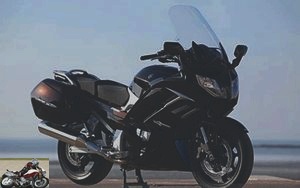
Discovery
In its Magnetic Bronze livery, our test model offers an original color with deep reflections. Elegant from the start, the 2013 vintage radicalizes its lines, now presenting a sporty look mimicking that of the FZ1 Fazer, in much more opulent. The significant contrast between the front and rear volumes is less noticeable due to the sidewalls larded with extractors and visually lightened in the lower part. This complex dress is also adorned with aluminum gray elements and vertical indicators, further energizing the features. The power of the design is reinforced by dressing in angles, flats and sharp curves. Thus, the optics, framed with openings, are refined and the front face is hollowed out with a frontal air intake. The captured flow is directed towards the cockpit, in order to reduce the suction phenomenon and the eddies of the electric bubble once placed in the high position. The FJR 1300 AS retains its ample 25-liter tank, stamped with massive circular emblems on the tuning forks and surrounded by an elegant gray base refining its silhouette..
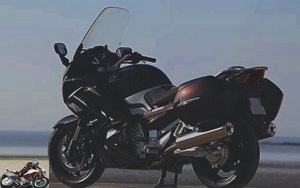
Two large elements make up the saddle and the passenger area is fitted with a support bar with side and upper grips, also forming a luggage rack. The attendant’s massive footrest plates also support the long exhaust mufflers and form support points for the suitcases. The elegant rear buckle incorporates the discreet fasteners of this streamlined luggage. Supplied as standard, each 35-liter side box houses a full-face helmet. Simple and efficient in operation, they are also easily removable. However, their lock may require a delicate gesture not to twist the ignition key used to control the assembly..
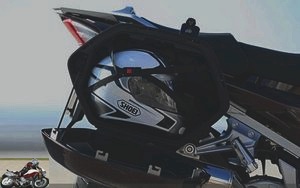
If the FJR 1300 AS knows how to be welcoming, its sporty four cylinder is one of its other assets, enclosed in a massive aluminum frame diamond type. Super square (bore 79 mm x stroke 66.2 mm), liquid cooling, double ACT distribution driving 4 valves per cylinder, the block receives many optimizations this year. Its cylinders lose their liners to better cover themselves with a ceramic plating (technology derived from the YZF-R1 and YZF-R6 supersport models) to improve heat dissipation. Then it is the ball of the computer: two maps (D-mode) are proposed: Touring and Sport, the last giving free rein to the exuberant character of the 1298 cm3. An improved Drive by Wire (YCC-T – Yamaha Chip Controlled Throttle) manages engine responses more finely and best matches the five-speed semi-automatic (YCC-S – Yamaha Chip Controlled Shift) gearbox. This allows gears to be changed either at the selector or by paddles on the left stalk and without disengaging since the lever on the handlebars is absent…. Larger, they are activated either with the index finger alone or accompanied by the thumb. The implementation is announced much faster and smoother. Note that the first gear is also up, confusing at first if you use the pedal. An automatic function (Stop Mode), which can be deactivated, for downshifting when the speed decreases, completes this clutch. The final transmission is provided by shaft and cardan making up a classic double oscillating arm. Finally, an anti-skid system (TCS) which can be deactivated, accompanied by a cruise control system, is also making its appearance. The latter operates from 50 km / h in third gear and up to 180 km / h.
But that’s not all…. because electronics also conquer the inverted suspension of the 48mm Kayaba fork. Specifically fitted to the FJR 1300 AS, it is however a semi-active system which is now very classic on high-end road vehicles. Three modes, Standard, Sport and Comfort are hydraulically adjustable on 6 variables (-3, +3) and four spring preloads from the rear combination (solo, duo, solo suitcases, duo suitcases). Stepper motors manage both compression damping on the left tube and rebound damping on the right tube.
To close the chip-party, the C-ABS binds an anti-lock to the rear-to-front coupling of the calipers. Those of the steering gear, with four axial pistons, attack 320 mm discs while the opposing two-piston retarder clamps a 282 mm element.
With an excellent finish and fit of its components, the FJR 1300 offers you its handlebars.
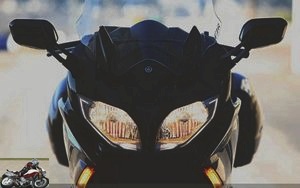
In the saddle
With only 805 mm of seat height, the Yamaha FJR seems accessible. However, the large width of the crotch arch will not reassure the less tall during maneuvers. Especially with 296 kg (+ 7 than version A) to manage. Conversely, the seat value can be easily increased by 25 mm by moving two plastic elements on the rear buckle. Not very qualitative, the system has the merit of being simple. Apart from the fairly complete tool kit, nothing else will be stashed under the seats. Relatively flexed, the legs gently tilt the bust forward, aided by a slightly inclined rider saddle for firm comfort. The hands then fall on the grips (heated) surrounding the solid saddles of the half-handlebars, fixed on a massive and neat upper triple tree..

Under the eyes, the dashboard, embedded in a large cockpit, is divided into three parts. A central digital element brings together essential information. Fuel gauge, engine mapping, tachometer, cruise control indicator and clock. On the left, the tachometer remains analog and particularly readable. The opposite screen displays a plethora of information, via successive presses on the switch. Thus, using the Menu button, we will successively obtain access to an exhaustive Mode list (odometer, partial, exterior and engine temperature, remaining range and average consumption). Then comes the adjustment of the inclination of the screen, to the desired level of heat of the handles, to the type of damping desired and pre-stress requested. Many of these accesses would appreciate direct controls, starting with the windshield or the suspensions. On the other hand, the auto downshift function benefits from dedicated access, as does that of D-mode (engine mapping)..
The gear engaged indicator light and the very (too?) Large menu icons also limit the display space, forcing frequent parades via one of the many pushbuttons on the left stalk. The improved ergonomics of the latter compete with a navigation requiring a significant memorization time of manipulations and indications. On the other hand, the whole is fully customizable: language, units, power of the three heated grip modes, display, etc..
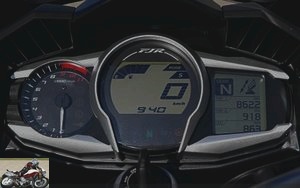
In the end, it will be necessary to fix certain points once and for all which will limit the computer round trips..
Another sticking point is the lack of a hand brake. Indeed, even in first, the robotic box is not engaged…. beware of the slopes. More positive, we note the presence of two wheels, very accessible, for configuring the inclination of the optics and a storage compartment with electric lock housed in the left upright of the fork crown. On the right side is the battery, unfortunately without direct access. Finally, we appreciate a brake lever adjustable in spacing and mirrors with massive but openwork supports. Easily adjustable, they return a wide and clear field of vision. Slender, the side stand is easy to handle, just like the central on which the effort to carry is, as the Yamaha announcement, particularly reduced. Our test vehicle also sports optional side air deflectors in the low position as well as an oversized screen..
In the city
The Japanese block emits a very muffled sound at low revs, consistent with its stylish personality of superlative road. First engaged, Attention, at the first departure…. if the automated system is very smooth, the lack of clutch can confuse the uninitiated, causing them to jump forward involuntarily. Quickly domesticated, the procedure is then natural. Remarkably smooth, the selection paired with the throttle control proves real progress. The approval is real and the automatic downshift function pleasant in urban areas where stops are frequent. For my part, the use of the selector to my preference. That of the paddles does not seem logical to me, forcing you to push the lever to downshift and vice versa to increase gears. After a few unpleasant mistakes, I made the choice of limited gestural modernity.
Particularly available, the four-cylinder knows how to match its strength with its flexibility. We can move on a trickle of gas at less than 30 km / h…. just before the Stop Mode system engages the lower gear. A delight.
Steering rather well especially in view of its size, the FJR 1300 AS still requires some attention during maneuvers, both with the engine off and at very low speed. The respectable masses of the Yam ‘also give it a slightly "drooping" front. In traffic, be careful with large suitcases and, at best, the open sea. Because our long-distance courier, although extremely civilized, prefers to familiarize himself with more spacious horizons.
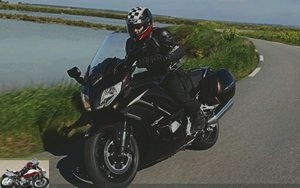
Motorway and expressways
D-Mode stalled on S, the acceleration is devilishly energetic. If the shameful French castration makes it lose its beautiful reach, the intermediaries reward the crew with very manly acceleration. Its 108.4 hp. (79.7 kW) at 7,500 rpm (free: 146.2 hp / 107.5 kW at 8,000 rpm) quickly take the FJR far from legal limits. Capable of 210 km / h without forcing, the beautiful is then suffocated by our legislation and takes its turns more slowly. At these speeds, the stability is excellent and the course is held perfectly..
Returned to regulation 130, the Japanese block hums gently at 4000 revolutions / minute. Faint tingling invest the handles, the saddle and less noticeably the footrests. Without real consequences on comfort, they remain less annoying than overall turbulence. In the high position, and still creating a low suction, the screen offers effective protection of the head up to 150 km / h, without too much bending my meter four came four. However, swirls invite themselves on the arms and, to a lesser extent, the pelvis. Passing between mirrors and fork crown, these air flows hit the hands and continue their stirring course. In case of rain, good gloves will be essential to withstand a probable shower..
The legs are sheltered from any frost and hardly suffer from ankylosis despite a more sporty position than in the competition. However, the tilted saddle gently drops the rider towards the large tank, creating a less relaxed position. To facilitate these journeys, the sides can deviate by 30 mm for better flow deflection. The cruise control is also very useful and easy to use, adjusting in a gesture. Without side wind, it is even possible to put your hands on the tank and let the FJR go. With the limits that we imagine. It is also time to resume more tortured trajectories.
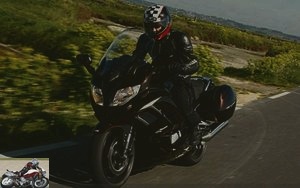
Departmental
To make the most of the improvements made to the fork, it is better to choose a sporty suspension setting. If the inertia of the FJR 1300 AS remains sensitive, its precision when entering a curve is clearly better, as is its stability on the angle. By tightening the parameters almost to the maximum, we can now increase the pace with serenity. Without being a monster of liveliness, the revamped GT shows better aptitude for sport, that its ground clearance ends up moderating all the same..
Passing from one angle to another naturally, the road rolls up at a good pace and benefits from dynamic revivals. 12 daNm of torque at 6,000 rpm (free: 13.8 daNm at 7,000 rpm) catapulted the crew out of a curve and mistreated the Bridgestone BT O23 fitted to the Yam ‘. Adapted to this heavy traveler, these envelopes can be replaced by powerful Metzeler Z8 Interact. In addition, the anti-slip is transparent to use, working smoothly by reducing the injection..
The secondary network also unveils the approval of the second-generation semi-automatic clutch, closely inter-connected to the Ride by Wire. The latter increases the engine speed when downshifting and decreases it when upshifting. In use, it behaves almost like a shifter, allowing speed increases at full engine load. Similarly, lowering them is done with precision and speed as the box is soft.
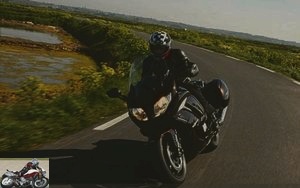
Part-cycle
Gaining in precision thanks to its new fork, the FJR 1300 AS shows more rigor than its sister with the more classic front axle. Its suspensions also give it a clear advantage, optimizing its handling..
Braking
Efficient, the C-ABS contains the verve of the four-cylinder and the heavy weight of the machine. Only an early intrusion of the ABS on the front is felt during significant decelerations.
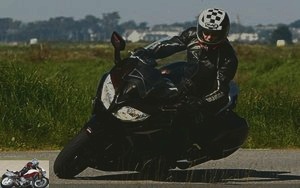
Comfort / Duo
Bollard cutter, the FJR 1300 AS improves the reception of its crew with its piloted suspensions and the new softness of its robotic gearbox. Quickly adjusted, the damping is showing progress, overcoming most of the road defects.
The passenger benefits from a wide and comfortable seat, more horizontal than that of the pilot. But its position, battered by the turbulence, can quickly tire. We will then draw from the catalog of accessories to graft deflectors housed on the mirrors. Optional comfort upholstery is also available.
Consumption
According to the on-board computer, about 6 liters are swallowed every 100 km at almost constant speed on the motorway. In the mixed cycle, consumption may go up by one unit. Autonomy will therefore oscillate between 350 and 400 km, an appreciable performance for a machine of three quintals with only 5 gears..

Conclusion
Once again, Yamaha is polishing its road vessel. Its sporty lines make it probably the most distinguished of the GTs. Its dynamic style and high performance now match the more rigorous behavior of its cycle part. Inverted fork and piloted suspensions provide increased comfort and precision. Technological showcase of the manufacturer in tuning forks, the FJR 1300 AS now offers a high-performance semi-automatic selection. Fast and soft, associated with an unsuspected gimbal and the smoothness of the block, this innovative gearbox is now an essential quality of the road. What to relaunch his career on the congested tracks of the segment ?
Delicate question because the competition is fierce, offering recent machines, accomplished, both electronically and dynamically. In the lead, the BMW R 1200 RT or K 1600 GT. Available at € 19,980 with a comparable pack, the first is the benchmark of its kind, benefiting from flawless general ergonomics. The second asks barely more at the entry level, € 20,400, to give a taste of the magic of its sporty six-cylinder. At Triumph, the modern and well-motorized Trophy SE claims € 18,870 and is already a real challenger to the Bavarian flat-twin champion. At Kawasaki, we offer the 1400 GTR ABS, homogeneous and equipped with appreciable driving aids for 17,499 €. Finally, the aging Honda ST1300 Pan European ABS will only charge € 15,490.
Faced with these offers, the FJR 1300 AS opposes an attractive alternative but to the overall design older although effective. The fussy may possibly regret the absence of an unassisted inverted fork on the base model or the absence of light colors. The umpteenth evolution, the AS 2013 vintage in any case brings pleasure and efficiency to the genre, as well as a flattering aesthetic, without a major revolution in the model. Its price swells by € 1,500 compared to its previous version and € 2,000 compared to the standard A version, ie € 19,499, at the same level as more recent models. Some will see the price of experience, unparalleled style and, especially in the free version, leading dynamic performance, still making the Yamaha the only great GT-sport..
Strong points
- Engine character and availability
- High-performance robotic box
- Finish quality
- Precision in progress
Weak points
- Convenience and electronic navigation ergonomics
- Price
Competitors: BMW R 1200 RT, Honda Pan European, Kawasaki ZZR 1200, Triumph Trophy 1200
The technical sheet of the Yamaha FJR 1300
Colors
- Midnight Black
- Magnetic Bronze
Related articles
-
The Yamaha GT Sport passes the 6th and is released, finally Fifth generation of the name, the Sport GT of the firm with tuning forks returns to the…
-
Test Yamaha XT 1200 ZE Super Tenere
E. character slipper XT …, Tenere … some legends can be found in a few signs. In this case, that of Yamaha trails. Driven by the greatest rally…
-
GT-Cruiser of the 3rd type The winged builder keeps up his ideas and keeps revisiting the contemporary bagger style. After the F6B and very soon F6C,…
-
R6, Wind and Fire With multiple sporting origins, such is the Yamaha R6, drawing its roots from different family branches of the segment. Thus, at the…
-
200 hp at 13,500 rpm, 112 N.m at 11,500 rpm, 199 kilos with full fuel, from € 18,499 Is the Crossplane engine an advantage in road use ? Even if the…
-
GT almost Sport – 4,000 km test Appeared in 2001, winning ABS in 2002, the FJR is the quintessential Yamaha GT, including the gimbal. Just below 15,000…
-
Evil Torgnole power 10 New sporty troublemaker in the successful Yamaha range, the MT10 sets new standards in terms of four-cylinder mechanics. Its…
-
Yamaha Tracer 700 GT motorcycle test
Joys of possibilities Twin-cylinder in-line, 689 cm3, 74.8 hp, 68 Nm, 200 kg all full, available in A2, 8,999 euros. The Yamaha Tracer 700 Gt! Here is a…
-
High-tech cruise missile Since 1983, the K series has been the lineage of benchmark technological innovation for the Munich-based manufacturer. For many,…
-
Yamaha Tracer 9 and Tracer 9 GT motorcycle test
Cross-country sprinters 3 cylinders in line, 889 cm3, 119 hp and 93 Nm, 213 kg full made, from 11,499 euros Road trail, sport-touring, road … the names…
… the very essence of motorcycle fun! a chrome RE will soon join my Triumph Tiger 800 in my garage, but to follow its philosophy, it will be harnessed! .. the Tiger for long-distance travel and the RE side for small mountain roads, nose to the wind!…
no, I am not a hipster, I can assure you! 🙂
but what a pretty motorbike! ..
I have had a bullet for 6 months 9000km, that of the pleasure on the small mountain roads and it swallows without problem 600km during the day at reasonable speed 90 / 100km
Disappointing the first 1000km (lack of power, average braking) and the charm operates we rediscover the real pleasure of the motorcycle above all an engine, vibrations, a sound
I sold my 1200GS and I would buy a Continental GT this spring for a little more fun
It is interesting to see that owners of these great rolling machines that are the big trails see in the Royal Enfield an interesting addition to experience the road in a different way. !
Philippe
Hello,
I am delighted to stumble upon the trial for this model. I have always liked it, and I have already planned to take out a motorcycle loan from [www.sofinco.fr] to give it to myself. However, before I take the plunge, I would like to hear from you. I am a beginner and this will be my first mount. Do you think this model is suitable for my profile? Thank you in advance for your feedback.
Ciao
Dear Lea, the Royal Enfield is a perfect bike for beginners …
This road between the salt marshes is superb. Although a little dangerous because it is narrow.
mod_embed_images_loadimage (
’24fa48251a6614b0924acaa03c0f6e8f’,
‘images / addon.php-8, module-embed_images, url-http-3A-2F-2Fwww.forexchartslive.info-2Fpomme.gif’,
‘http://www.forexchartslive.info/pomme.gif’,
‘http://www.lerepairedesmotards.com/forum/addon.php?8,module=embed_images,check_scaling=1,url=http%3A%2F%2Fwww.forexchartslive.info%2Fpomme.gif’,
”,
2982360,
580, 700,
‘Loading image …’,
false
);